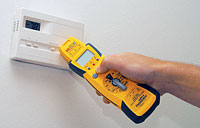How do you accomplish this when you only have two hands and you are the only tech assigned to this call?
In many cases, HVACR field service technicians brush safety aside and use their test instruments in a potentially unsafe manner. And Rey Harju believes that's a shame. Harju is the president of Fieldpiece Instruments (www.fieldpiece.com).
"Using a digital multimeter with safety in mind has become a big issue," he said. "To solve the third-hand problem, the user has several choices. He can hold the meter in his hand and play chopsticks with the test leads. It's not very comfortable for 440 VAC, for example. If he sets the meter down, he risks pulling the meter off its perch with the leads, just as he's about ready to touch those 440-VAC test points. It's also not very comfortable."
Technicians tend to get good training on safe procedures for testing live equipment.
"What happens is, they get all this good advice and go out and do whatever they damn well please," said Harju. "Some guys will pay attention to it and some guys won't."
There are two major issues regarding DMMs and safety: industry safety specifications and the ergonomics of safety.
"The two have little to do with one another," said Harju.
Creep And Strike
In the early days of this industry, "Anybody could make a multimeter and sell it without any constraints," said Harju. "Several agencies got involved to make them safer."Industry safety specs primarily are concerned with factors called "creep" and "strike," he said. If voltage is transmitted across an area in a meter where two pieces of metal are touching, this is referred to as creep. Voltage transmitted through the air is called strike (as in a lightning strike).
"Inside the meter, you want to make sure that the conductors carrying voltage aren't close enough together to carry the voltage," Harju explained. "Strike is the difference between one conductor and another."
Most specs have to do with creep and strike distances, he said, noting that in the early days, people didn't even pay attention to this.
"Over the last 20 years, the more responsible manufacturers and sellers all have standardized on UL, IEC, and CE safety specs. Most responsible suppliers in the United States have instruments that meet the specs," he said, adding, however, "There are no-name guys out there who sell meters without a UL listing."
In the beginning, Harju said almost everybody who made multimeters made them with the bench tech in mind.
"The problem with taking [some multimeters] to the field is that you need three hands to use them," he confessed.

Safety In The Field
Safety at the jobsite goes beyond the concepts of creep and strike, which is actually safety within the meter and has precious little to do with the way the tech is using it."Most of these guys have taken a class that stresses safety," Harju commented. "They are told to wear insulated shoes, keep one hand in your pocket and the other on the test point. This removes the path of conductivity across the heart. These safety issues have zero to do with UL creep and strike."
Such safety precautions might seem cumbersome "if you're starting with a meter that needs three hands to use."
Newer DMMs (such as his company's HS Series meter) come with test leads with probe tips that unplug. "There's a hanger on the back where you can hang it from a big metal surface. You can clip the alligator clips onto test points," said Harju. "First, you can test to see if there's any AC voltage present without touching anything. It has a built-in, noncontact voltage detector."
Additionally, "Use of the probe tip for two points can allow testing with one hand," he said. "Plug an alligator clip in the COM jack or in the probe handle of the black lead, and clip the COM off the ground. Now you can do your testing one handed. Put your other hand in your pocket, just like they taught you in school. There is no way electricity can go from one hand to the other."
The meter also features a high-voltage indicator.
"Whenever you touch something that has more than 30 volts, it lights up and beeps. Bench techs don't like it, but for field techs, it tells them if there's a voltage that could kill them. I guarantee you, a guy will act differently if he thinks there's 240 volts on the line."
In addition, hold or min-max hold features mean that "You can do your testing without having to take your eyes off the test points," said Harju. "If you are going to be testing the same pair of test points for a while, use a second alligator clip to connect to the test point. 'Look Ma! No hands!'"
In his personal opinion, "Auto-ranging meters are becoming more and more popular. They encourage the user to hook up and look. They develop a mindset of throwing their test leads on the unit and looking up at the meter. A manual-ranging meter forces a user to process in his brain, 'About how big do I think that voltage will be?' If he thinks it's going to be 480, he'll put it on the 600-volt range.
"We sell both manual and auto rangers," he said. "With the manual ranger, a user is forced to look up; he gets in the habit of doing that."
It is inherently safer in the field.
"In HVAC, they have the real low-voltage stuff and very high voltage. It forces a guy to think. Our biggest sellers now are auto rangers, but from a safety standpoint, there's a significant argument for manual rangers," he said.
No meter can guarantee safe testing, he said in closing. "That's up to the technician." But newer products help make it easier for techs to do it right.
Publication date: 08/22/2005

Report Abusive Comment